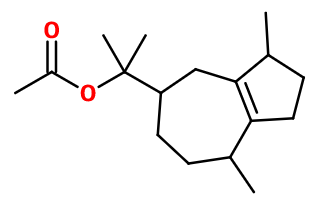
Photo credits: ScenTree SAS
Do you sell any of the raw materials? Would you like to let our users know?
Send an email to fournisseurs@scentree.coto learn about our advertising opportunities.
Do you sell any of the raw materials? Would you like to let our users know?
Send an email to fournisseurs@scentree.coto learn about our advertising opportunities.
General Presentation
-
CAS N° : 134-28-1
-
EINECS number : 205-135-0
-
FEMA number : Donnée indisponible.
-
FLAVIS number : 09.808
-
JECFA number : Donnée indisponible.
-
Appearance : Colorless to yellow liquid
-
Density : 0,978
-
Volatility : Heart/Base
-
Price Range : €€€
Physico-chemical properties
-
Molecular formula : C17H28O2
-
Molecular Weight : 264,41 g/mol
-
Log P : 5,85
-
Fusion Point : Donnée indisponible.
-
Boiling Point : 120°C (à 3 hPa)
-
Detection Threshold : Donnée indisponible.
-
Optical rotation : Donnée indisponible
-
Vapor pressure : Donnée indisponible
-
Refractive Index @20°C : Donnée indisponible
-
Acid Value : Donnée indisponible.
-
Flash Point : 94°C
Uses
Uses in perfumery :
Gaiyl acetate is used for woody accords, fougere and leather perfumes. Good for creating ''Christmas '' style atmospheres and for providing a ''comfortable '' woody feeling. Less used in fine fragrance than in consumer products.
Year of discovery :
Data not available.
Natural availability :
Gaiyl acetate is derived from a natural product because it results from the acetylation of Gaiac Wood EO. This raw material is called ''hemi-synthetic ''.
Isomerism :
Gaiyl acetate (exclusively from Gaiol) is a molecule with three asymmetric carbons. In most cases, a mixture of all this molecule's enantiomers is used. Nevertheless, enantiomerically pure qualities of this raw material exist and are used for their olfactive quality. The two major compounds in this mixture, Gaiyl acetate and Bulnesyl acetate, are positional isomers. Their unsaturations are not located in the same place in the same molecular body. Moreover, Gaiyl acetate is a constitutional isomer of Cedryl acetate. Both, however, do not share the same smell.
Synthesis precursor :
Gaiyl acetate can be decarboxylated. This means that the molecule is heated very strongly (about 572 °F) to be pyrolyzed and Gaiene is synthesized.
Synthesis route :
Gaiyl acetate is actually the product of the acetylation of Gaiac Wood EO. It is a reaction that consists in associating the alcohols of the essential oil with an acid to make esters. As this essential oil is mainly composed of Bulnesol and Gaiol, the product of this reaction is mainly composed of Gaiyl acetate and Bulnesyl acetate. To improve the yield and shift the equilibrium of this reaction, the producing companies use acetic anhydride, which is a much better option than acetic acid. A catalytic amount of a strong acid such as sulfuric acid is also used to promote a good yield. The molecule rigorously called Gaiyl acetate can be obtained by distilling the acetylated essential oil to isolate the desired molecule from the other molecules of the mixture.
Regulations & IFRA
Allergens :
This ingredient does not contain any allergen.
IFRA 51th :
This ingredient is not restricted for the 51th amendment


